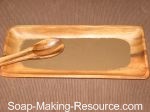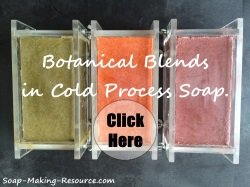Soap Making Dye
The types of soap making dye that are used today vary greatly amongst soap makers. Today I will be discussing in detail the four main types: FD and C dyes, pigments, micas and natural colorants.
Some soap makers prefer the completely natural approach, while others don't mind using synthetic ingredients in order to achieve their desired color. It's really up to you! I must say that, many new soap makers probably don't realize the possibilities available with natural colorants. Synthetic dyes certainly do not need to be used in order to achieve a beautiful product.
I can tell you that once you enter the world of natural soap dyes, you will likely be hooked like me. It's so much fun and really allows for ones creativity to flourish. I actually prefer the colors offered by unique natural dyes. Nothing screams "natural" and "homemade" quite like earthen colored soaps and that's the exact feel I'm personally trying to go for.
 |
 |
 |
 |
 |
 |
 |
 |
5% Off Orders of $100 - $199 10% Off Orders of $200 - $299 15% Off Orders of $300+ *not valid with any other coupons |
|||
Sign up for the Soap Making Resource e-Newsletter. |
|||
Orders Outside the USA Please Click Here. We Ship Worldwide! |
|||
Of course, there are other options available for those soap makers who don't mind using some synthetics in their products.
The question is: Are you willing to sacrifice the naturalness of your soap's composition for color?
If you answered yes, then keep reading. Below, I will go over some of the other soap making dye options that are available to you like FD and C dyes, pigments and micas.
|
Sign Up Today!
*Your information is SAFE with us! |
If you answered no, and prefer to use natural colorants in your soap, then please click on the link mentioned above. You can also read further down this page for a list of ingredients you can use as non-synthetic soap making dye.
Please understand that using non synthetic colorants is merely my personal practice based on a desire to create a completely natural product. Everyone is unique and has different purposes for creating soap at home. Yours may not be focused on avoiding synthetics.
- Maybe you don't really care if you have a small percentage of unnatural material in your soap if it means a beautiful finished product.
- Maybe you're making soap with your children and they prefer a brighter synthetic soap making dye over the organic natural colorant look.
- Maybe you're creating your soap specifically for decoration and therefore need bright and pretty colors.
- Or... Maybe you just like using FD and C, micas or pigments better then botanicals and clays for coloring! That's ok... many wonderful and talented soap makers use these types of coloring agents.
We all have our own preference and purposes for homemade soap making, so you should choose the type of dye that best fits your needs and wants.
Below I will go over the main soap coloring methods used today in the homemade soap making industry.
FD and C Colorants
FD and C colorants are used as a soap dye by some crafters. They are produced in a lab synthetically. FD and C stands for food, drug and cosmetic act. Each dye usually has a number associated with it like yellow #5, Green #8, Red #40 etc. These colorants are very popular in the food industry and can be found in many processed goods.
FD and C colorants have a very wide range of colors available that come in both powdered and liquid form. They are relatively inexpensive adding very little to your cost per bar. In soap making they are mainly used in melt and pour soaps as they are not very stable for cold process soap making. Just be aware that FD and C colorants do tend to bleed!
Soap Making Pigments
Soap Pigments include both ultramarines and oxides. Although many pigments were once taken naturally from the earth, they are now replicated synthetically in a lab for consistency and safety. This was enforced by the FDA because when mined naturally, these pigments also included some toxic materials that the FDA deemed as unsafe.
Ultramarines and oxides are very stable in soap making and can be used in pretty much all soap making processes including melt and pour, cold process and hot process. They are quite inexpensive and come in a large variety of colors. Pigments are probably the best synthetic color source for swirls as they will not bleed at all. Just make sure that you mix the colorant into your batch thoroughly. They can clump in one spot if you're not careful!
Micas
Micas are used as a soap making dye in cold process, hot process and melt and pour soaps. Not all micas, however, are stable in cold process and hot process soap making; so tests should be performed before large amounts of ingredients are committed. All mica colorants have a glittering effect to them when the proper lighting is present. This is best seen in soaps made with a clear melt and pour base. Micas are available in a large variety of colors. They, unfortunately, are not completely natural as synthetic colorants are often used to coat the mica and give it its hue. They are very easy to use in soap making as you don't have to worry about clumping like you do with pigments. Unfortunately, they are a little more expensive then other soap making dyes out there as substantial amounts need to be used per batch.Natural Colorants in Soap Making
Natural soap colorants can be produced with a variety of herbs, spices, clays etc. Here is a list of natural soap making dyes:
| Light/Dark Brown | yellow | Green | red | Salmon | purple |
| black walnut hull | safflower Powder | Burdock Leaf | madder root | Cayenne pepper | alkanet root |
| ground cloves | turmeric | Comfrey Leaf | sandalwood powder | paprika | |
| all spice | annatto seeds | Deandelion Leaf | moroccan red clay | ||
| nutmeg | calendula petals | French Green Clay |
How much colorant should you use? The general rule is one tablespoon of the botanical in powdered form per pound of oils, but this can change from colorant to colorant. Some natural soap making colorants should not be added in powdered form, but should be infused in liquid oil before using them in your batch. Don't worry... that process is easy and fun!
Your best bet is to ask someone who has already used the botanical what method and rate they find works best. There's no way of telling exactly how it will turn out if you merely guess... but that could be part of the fun for some of you more adventurous soap makers out there! On my natural soap colorant page I do go over my usage rates for the natural soap colorants.
Also, you should keep in mind that the shade of these colors can drastically change from recipe to recipe. The final results depend on which oils and fats are used, whether or not you decide to allow your soap to gel, how the soap dye reacts to lye, and sometimes which essential oils or fragrances make up the soap's scent.
Not knowing exactly what it will look like is part of the excitement! Have fun and experiment with the various colors available to you. If you use the above table as a guide, and use common sense when combining colors, your soap will always look good no matter what... maybe a little different every time... but good nonetheless.
Adding the Soap Making Dye
Most soap making dye, especially the synthetic types, can be added at trace before pouring the soap into the mold during the cold process soap making procedure. Some natural botanical colorants are best used when infused with a liquid oil being used in your recipe. Others work well by adding a powdered form of the plant at trace. It really depends on the natural colorant.
Keep in mind that during trace and the initial curing stage in the cold process, the big bully lye is still active and will change some natural and synthetic soap making dyes. This is not necessarily a problem as long as you understand that the colors may turn out a little differently (not necessarily worse) then you expected. Most synthetic dyes that are made for soap making are more consistent and don't have a tendency to change as much. Pigments, as mentioned before, are probably the most stable. FD and C and some of the micas you need to watch for color changing.
Some Final Soap Making Dye Thoughts
Remember to always use soap safety precautions when working with both natural and synthetic colorants.
If you decide to experiment with coloring soap, be sure to review each material before using it.
- Make sure that it's not a common allergen.
- Make sure that it's not irritating to the skin.
- Make sure that it has a pleasant scent that is not too overpowering.
It's always better to be safe then sorry!
Hopefully, you now have a better understanding of how to color your soaps, and what to expect during this process. Keep in mind that soap making is often difficult and frustrating for the perfectionist. You need to be flexible and accepting of the results, especially when it comes to coloring. Experiment and have fun. It won't take long to become a soap coloring pro!











